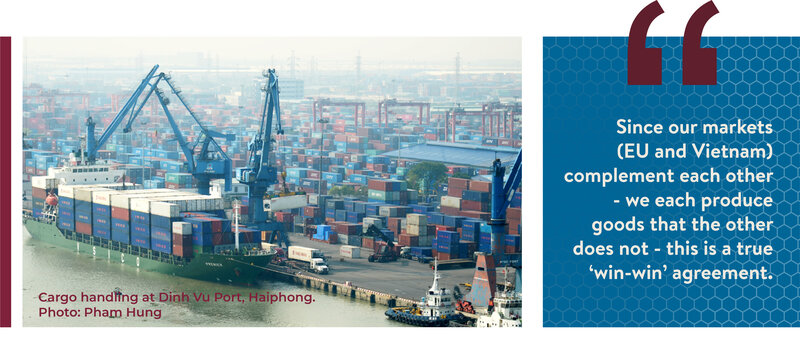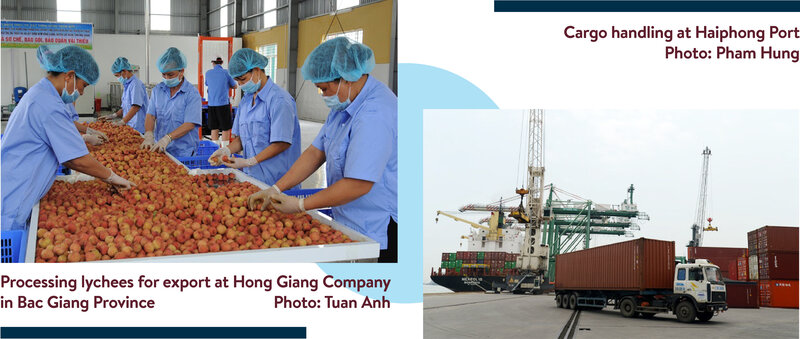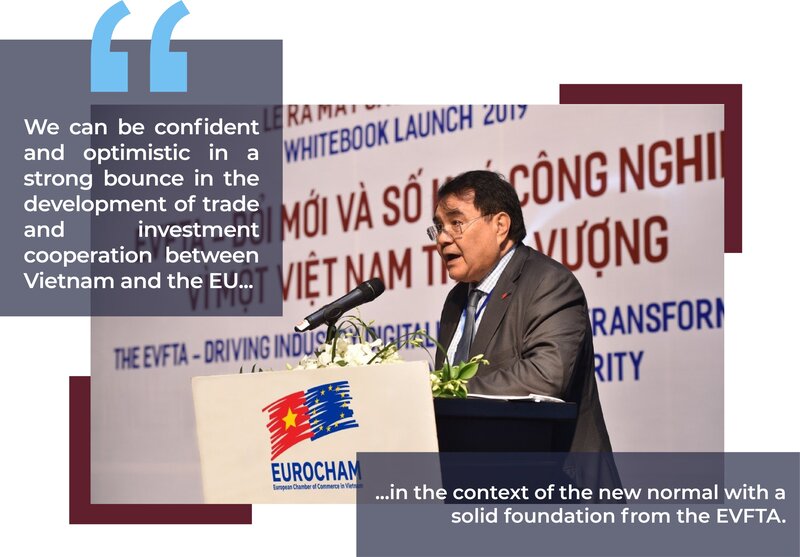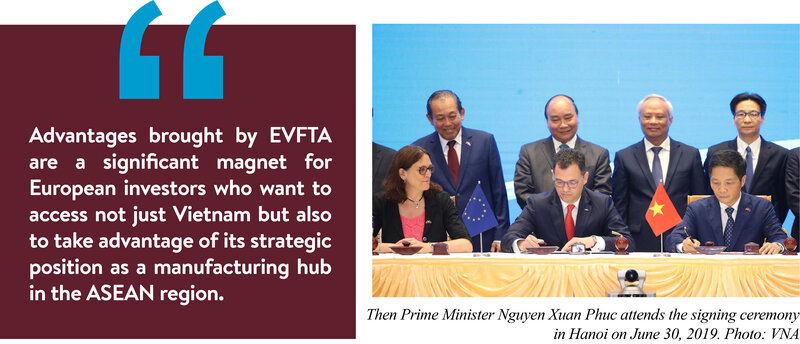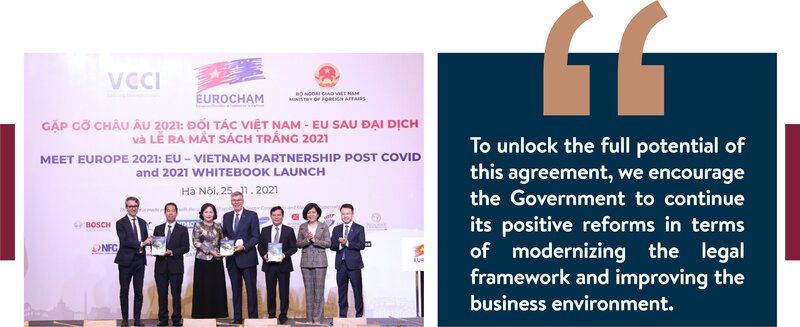EVFTA - Magnet for European investors to Vietnam : EuroCham
Vietnam and the EU can expect a strong bounce in the development of trade and investment cooperation in the context of the new normal with a solid foundation from the EVFTA.
EuroCham Vietnam’s Vice Chairman Jean Jacques Bouflet told The Hanoi Times the impacts brought by the EU-Vietnam Free Trade Agreement (EVFTA) to both sides one year after the deal kicked off and also his foresight on it.
Being a new generation FTA, in force since August 1, 2020, EVFTA ushers in a new era of EU-Vietnam trade through a gradual elimination of tariffs and a mutual opening of markets. In the upcoming decade-long implementation period, it will phase out almost 99% of tariff lines, remove barriers to trade, and support Vietnam to meet international standards in its legal framework, environmental standards, and investment landscape. And since our markets (EU and Vietnam) complement each other - we each produce goods that the other does not - this is a true ‘win-win’ agreement.
Looking back at a year of implementation of the EVFTA, we cannot deny the role of the Agreement: this is not only a lever to promote two-way trade but also a preeminent advantage for the business communities of the two sides in the current context. The figures on trade exchange even during the epidemic outbreak in the EU and Vietnam prove this.
After one year since the EVFTA came into effect, Vietnam's export turnover to the EU market has reached US$39.75 billion as of August 1, 2021, up 6.2% over the same period last year. This increase is due to the recovery of the EU economy in the second quarter of 2021. At the same time, the impact of tariff reductions on Vietnamese products entering the EU market helps promote exports of items that benefit from the EVFTA.
From the EU side, one year after the Agreement came into effect, the total import volume of goods from EU markets into Vietnam reached $16.51 billion, up 24% over the same period last year. Major items from the EU include pharmaceuticals, other machinery, equipment & tools, and chemical.
More and more businesses are taking advantage of incentives from the EVFTA Agreement through the use of favorable certificates of origin (C/O). In addition, enterprises exporting goods to Europe also carry out self-certification of origin for 6,115 consignments entitled to preferential tariffs under EVFTA.
The competitiveness and market share of Vietnamese goods have also improved significantly in the EU market. Vietnam has now become the EU's largest goods trading partner in the ASEAN region, ranking in the top 10 countries supplying the largest goods to the EU market.
Regarding investment, with a strong commitment to ensuring transparency and convenience in the investment and business environment, Vietnam has gradually received high-quality investment from the EU with projects with highly advanced technology, creating values and mutual benefits for the business communities of both sides.
It should also be noted that EVFTA comes into force in the context of the epidemic outbreak with critical consequences such as orders have declined, spending has fallen, value chains have been interrupted as social distancing and other public health measures brought normal commercial operations to a standstill. The shortage of workforce and the consequence of the 3-at-site model of operation in enterprises in Vietnam is also an important barrier to meeting the demand of the EU market leading to the decrease of the export turnover to this important market.
However, we have been delighted that, over the last 2 months, Vietnam has begun to emerge from lockdown and resume normal business activities. The Government’s ambitious and accelerated vaccination rollout - combined with the tireless and heroic work of front-line healthcare professionals - has kept cases low and enabled the gradual re-opening of both companies and communities.
This evidence-based action is now giving our members renewed optimism about the prospects both of their enterprises and Vietnam’s business environment. We can be confident and optimistic in a strong bounce in the development of trade and investment cooperation between Vietnam and the EU in the context of the new normal with a solid foundation from the EVFTA.
EVFTA is called a new-generation trade agreement because, in addition to commitments on free trade in goods and services (traditional FTA), it covers the deepest commitment level and areas considered non-traditional such as labor, environment, state-owned enterprises, Government procurement, transparency, mechanisms investment dispute resolution.
New-generation FTAs will help Vietnam further strengthen the state apparatus, in the direction of accelerating administrative reform, enhancing responsibility and discipline of officials, thereby supporting the process of transformation of growth pattern and economic restructuring of Vietnam.
As the result, Vietnam has taken some amendments to its regulations in line with commitments under EVFTA such as the Government issued Decree 111/2020/ND-CP, supplementing the preferential export tariff and the preferential import tariff for goods in the EVFTA commitment, the MOIT is drafting a circular to add regulations on refurbished goods to Circular 11/2020/TT-BCT.
However, Vietnam still has a lot of works to do regarding institutional reform. Specifically, the Ministry of Transport and Communications should soon issue the EVFTA Implementation Plan and complete the procedures for joining the UNECE Agreement to help businesses trading in motor vehicles and motor vehicle spare parts and equipment participate in the market more easily, taking advantage of incentives from EVFTA. Other contents must also be amended such as the content on public procurement, transparency, intellectual property, telecommunications activities, rights of workers, commitments on climate change, regulations on diversity biological, etc. It is highly recommended for Vietnam to continue revising and modernizing its legal framework to satisfy the requirements under EVFTA.
Looking at the results of two-way turnover between Vietnam and the EU, it can be seen that Vietnamese and European businesses have begun to take advantage of the trade advantages brought by the EVFTA. These advantages are a significant magnet for European investors who want to access not just Vietnam but also to take advantage of its strategic position as a manufacturing hub in the ASEAN region.
This attraction will be boosted even further once the EU-Vietnam Investment Protection Agreement (EVIPA) enters into force. This will give investors greater confidence to invest here and better protection for the capital contributed to the market through an innovative dispute-resolution mechanism and other guarantees, such as against expropriation without compensation. Unlike the EVFTA, this agreement requires individual ratification in each EU Member State, an ongoing process.
However, the fourth wave outbreak in Vietnam has caused interruptions for businesses and supply chains. Even those companies who are allowed to continue operating are encountering significant disruption. And this is having an inevitable impact on trade. Meanwhile, the continued restrictions on international travel – while essential to preventing the spread of the virus – remain a barrier to increasing investment. Business leaders will postpone major investment decisions while it remains so difficult to travel to Vietnam.
But, despite these short-term challenges, European business remains confident about the long-term prospects of trade and investment in Vietnam, which was reflected in our latest Business Climate Index.
First, the Government needs to further accelerate the mass vaccination drive. The Government has made good progress in securing vaccinations since the outbreak of this fourth wave. The challenge now will be to ensure that these doses can be delivered as fast as possible to the general population.
Longer-term, the EVFTA provides opportunities for Vietnam to boost trade and investment with the world’s largest free-trade bloc. However, to unlock the full potential of this agreement, we encourage the Government to continue its positive reforms in terms of modernizing the legal framework and improving the business environment.
In particular, the Government could continue its simplification of administrative procedures and streamline business conditions. This would create an even more competitive business climate for foreign investors. Meanwhile, we also urge further implementation of e-Government initiatives. This would help to reduce the bureaucratic burden on businesses and enable them to reinvest more capital into their commercial operations. Business leaders would also welcome further legislative reform; resolving conflicting and overlapping regulations and further reducing the number of ‘conditional’ business sectors.
On top of this, further upgrading Vietnam’s logistics infrastructure and improving transport links between ports, industrial zones, and major cities would help to secure further FDI in the future. We know that companies are looking at Vietnam as part of their China+1 strategies. However, Vietnam needs to continue leveling up its transport, logistics and supporting industries to take full advantage of this growing demand.
Thank you for your time!



